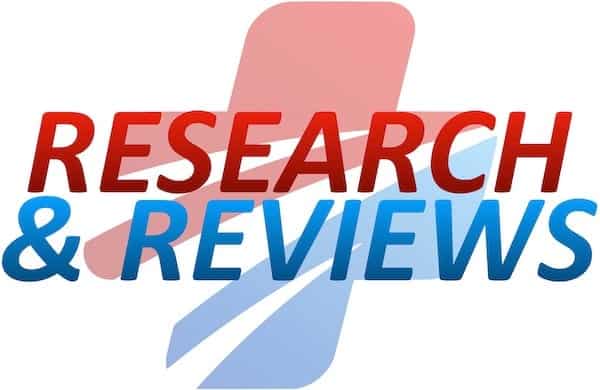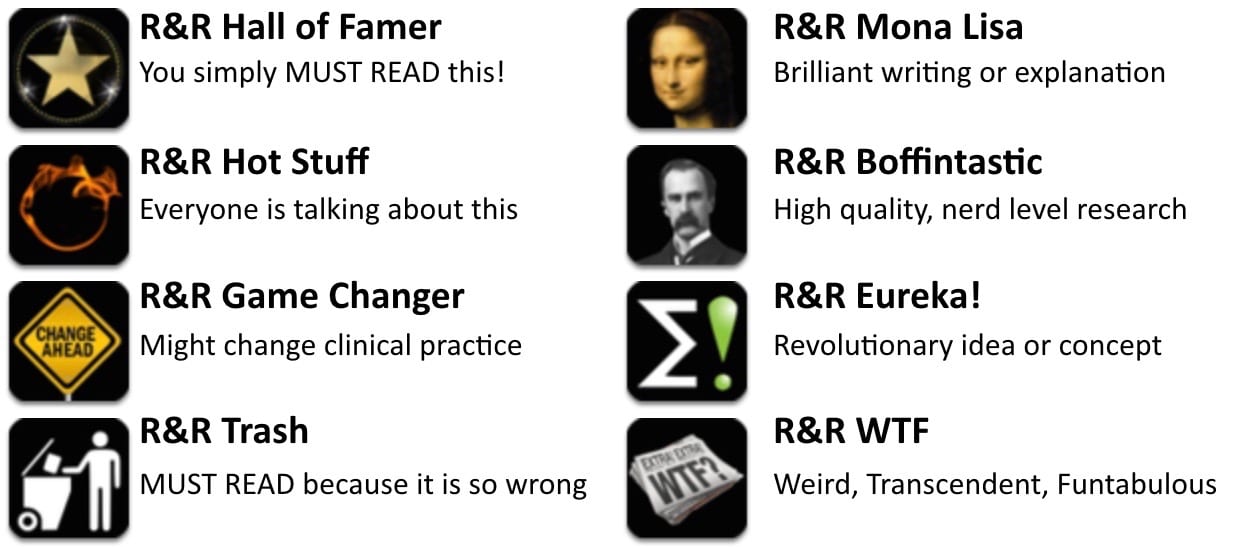R&R In The FASTLANE 088
Welcome to the 88th edition of Research and Reviews in the Fastlane. R&R in the Fastlane is a free resource that harnesses the power of social media to allow some of the best and brightest emergency medicine and critical care clinicians from all over the world tell us what they think is worth reading from the published literature.
This edition contains 6 recommended reads. The R&R Editorial Team includes Jeremy Fried, Nudrat Rashid, Soren Rudolph, Anand Swaminathan and, of course, Chris Nickson. Find more R&R in the Fastlane reviews in the : Overview; Archives and Contributors
This Edition’s R&R Hall of Famer
Abraham NS et al. Comparative risk of gastrointestinal bleeding with dabigatran, rivaroxaban, and warfarin: population based cohort study. BMJ 2015. PMID 25910928
- NOACs may not be as bad as we think and it appears that they are no worse than warfarin in terms of GI bleed risk. This is a paper analyzing a very large secondary database (Optum labs, millions of patients); comparing warfarin with dabigatran and rivaroxaban. The event rates are basically the same, with a trend for the newer NOACs to have less bleeding. Still the risk of GI bleed is quite clear and significantly more in elderly people.
- Recommended by Daniel Cabrera
Saver JL et al. Stent-Retriever Thrombectomy after Intravenous t-PA vs. t-PA Alone in Stroke. NEJM 2015. PMID 25882376
- The SWIFT-PRIME trial’s initial results were presented earlier this year alongside EXTEND-IA and ESCAPE at the 2015 International Stroke Conference. Like its counterparts, this trial examined patients presenting with large ischemic infarcts and radiographically identified occlusions in the terminal internal carotid (ICA) or first branch (M1) of the middle cerebral artery (MCA). Additionally patients had to demonstrate a favorable core-to-ischemic penumbra ratio on perfusion imaging and were able to undergo endovascular interventions within 6-hours of symptom onset.Authors boast a 25% absolute difference in the number of patients with a mRS of 0-2 at 90 days. Though notable, the definitive magnitude of effect is hard to interpret since the trial was stopped before its first interim analysis (<200)
- Recommended by Rory Spiegel
Kennedy HM et al. The “5Es” of Emergency Physician–performed Focused Cardiac Ultrasound: A Protocol for Rapid Identification of Effusion, Ejection, Equality, Exit, and Entrance. Acad Emerg Med 2015. PMID 25903585
- Emergency Physician Performed Cardiac Ultrasound (EP FOCUS) is commonly performed during diagnostic workups of undifferentiated patients. This article seeks to protocolize this modality into 5 specific assessments (the “5Es”): Pericardial Effusion, Qualitative Left Ventricular Ejection Fraction, Ventricular Equality, Exit (Aortic Root measurement/assessment) and Entrance (IVC diameter and respirophasic variation). This approach is a nice way to remind clinicians of all the areas EP FOCUS can assess. The article also highlights a number of pitfalls that can lead to misdiagnosis that are critical to understand.
- Recommended by Anand Swaminathan
Jovin TG et al. Thrombectomy within 8 Hours after Symptom Onset in Ischemic Stroke. NEJM 2015. PMID 25882510
- The REVASC trial planned to enroll 690 patients presenting to the Emergency Department in 4 centers across Catalonia with symptoms consistent with a large vessel stroke that could be treated with endovascular therapy within 8 hours of symptom onset. Unlike EXTEND-IA, ESCAPE or SWIFT-PRIME, the REVASCAT Trial did not use perfusion imaging to select patients with favorable areas of salvageable tissue. Rather employed CTA to identify occlusion in the ICA or M1 branch of the MCA, and utilized the less accurate ASPECT score, derived from the initial non-contrast CT, to assess potential for viable ischemic tissue. REVASCAT enrolled 206 patients before its premature termination. And like the three trials before it demonstrated a statistically significant improvement in mRS at 90 days in the patients who underwent endovascular therapy. The REVASCAT trial cites an absolute increase in the number of patients with a mRS of 0-2 by 15.5%. This is surrounded by a confidence interval of 2.4% to 28.5%. Furthermore, unlike the previous three trials that either boast an outright benefit in mortality or demonstrate trends in favor of endovascular therapy, REVASCAT demonstrated an impressive 4.8% absolute increase in the rate of death within the first 7 days after randomization. The results of REVASCAT are far from positive. If they were not included in the optimistic fervor that currently surrounds endovasacular therapy, it might even be considered a negative trial. These results certainly speak to the importance of correct radiological identification of patients who will benefit form endovascular therapy and the risks of applying this therapy to wrong patient population.
- Recommended by Rory Spiegel
M. S. Kristensen et al. Structured approach to ultrasound-guided identification of the cricothyroid membrane: a randomized comparison with the palpation method in the morbidly obese. Br J Anaesth 2015; 114(6): 1003-4. PMID 25991744
- Short editorial on how to teach a stepwise approach to ultrasonographic identification of the cricothyroid membrane.
- See more at www.airwaymanagement.dk and airwaylearning.com
- Recommended by Soren Rudolph
Schreiber MA et al . A controlled resuscitation strategy is feasible and safe in hypotensive trauma patients: results of a prospective randomized pilot trial. J Trauma Acute Care Surg 2015; 78(4) :687-95. PMID 25807399
- Permissive hypotension is recommended for the bleeding trauma patients before haemorrhage control, although optimal target blood pressures has not been defined. In this prehospital study 192 hypotensive ( sBP<90 mmHg) trauma patients were randomized to a permissive hypotension strategy using 250 ml boluses as long as sBP was < 70 mmHg or a standard (old school ATLS like) 2 L crystalloid and additional fluid as needed to maintain an SBP of 110 mm Hg or greater. Overall mortality at 24 hours was 5% vs 15% between the 2 groups (adjusted odds ratio, 0.39; 95% CI, 0.12-1.26). No difference was found in penetrating trauma patients but among patients with blunt trauma, 24-hour mortality was 3% vs 18% with an adjusted odds ratio of 0.17 (0.03-0.92).
- Together with Morrisons trial from 2011 that targeted MAP of 50 mm Hg vs 65 mm Hg in in-hospital trauma resuscitation, is study provides more evidens on resuscitation targets/end points that may significantly lower mortality i blunt trauma patients and coagulopathy.
- Recommended by Soren Rudolph
Senior Consultant Anesthesiologist, Traumemanager and PHEM doctor. Dedicated to trauma resuscitation, prehospital care and airway management. Barometerbarn | @SorenRudolph |







